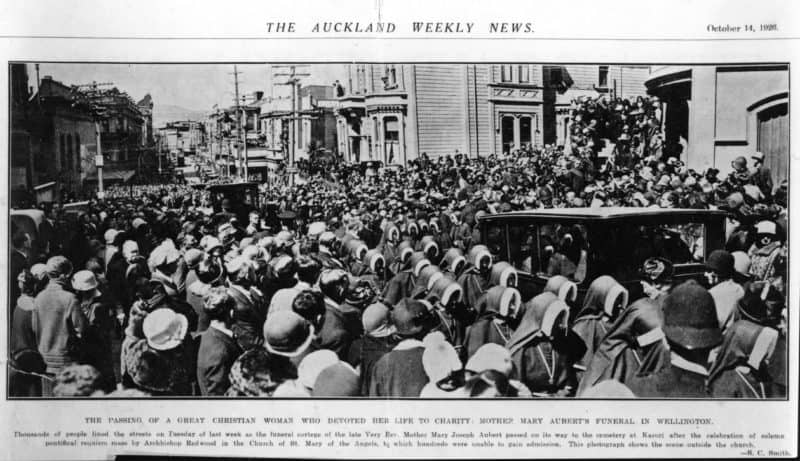The early days
Suzanne Aubert was a determined young woman who left Lyon in France to begin her lifelong spiritual journey as soon as she was legally free to decide her own future.
As a young woman, Suzanne had repeatedly but unsuccessfully asked her parents’ permission to join religious life. Finally, with the freedom to decide, at the age of 25, she accepted an invitation to become a missionary for Bishop Pompallier’s Auckland diocese.
After working initially at a boarding school for Māori girls, Suzanne left Auckland to work at the Marist Māori mission station at Meanee in Hawke’s Bay with the Third Order of Mary. She became well-known in the area ministering to Māori and Pākehā, Catholic and non-Catholic without compromising her own beliefs. Tolerance and friendship became strategies for her mission.
In 1874 Suzanne was pinning her hopes for a revival of the Māori mission on the new Bishop of Wellington, Bishop Redwood, who was to become her lifelong supporter. In 1883, by invitation of the Māori from the Whanganui River area, Suzanne left Hawke’s Bay for Hiruhārama/Jerusalem – to revive the Catholic mission.
It’s here that the home-grown Catholic congregation – the Daughters of Our Lady of Compassion – was born.
The birth of the Daughters of Our Lady of Compassion
“Never forget that we were first instituted for the Māori, that we began in the bush, and that we are concentrated to their service by our vows. They have the first claim on our love, on our care. A Māori village was the cradle of our institute”.
On Christmas Day 1885, Bishop Redwood blessed St Joseph’s Church. When it was burnt down three years later, Suzanne set off on a collecting tour of New Zealand, returning in 1893 with £1000 – enough to build a new church and convent.
In 1892 Archbishop Redwood appointed Suzanne as Mother Superior of the newly established Daughters of Our Lady of Compassion.

During her tour, Suzanne had become acutely aware of the challenges faced by poor and unmarried mothers and their babies. She took 74 babies and children into their care, but Hiruhārama was too isolated from medical services. So, Suzanne set her sights on Wellington, arriving unannounced in the city in 1899 with two Sisters.
Work starts in Wellington
The Sisters immediately started work with Wellington’s suffering and destitute planning a much-needed home. They set up a soup kitchen (that still operates today) and a crèche for children of working parents. The land was bought in Island Bay and, in 1907, the Our Lady’s Home of Compassion was opened.

Suzanne never stood still, her reputation spread far and wide. She rose to every challenge that came her way, travelling to Rome in 1913 at the age of 78 to present her case to the Pope.
More than four years later, Pope Benedict XV granted the Decree of Praise to the Daughters of Our Lady of Compassion. The Decree changed everything:
- It protected all the work she had started
- It widened her scope for healthcare
- It protected her resolution that their work would be for everyone
- It recognised her interpretation of New Zealand society and spirituality
In early 1920 a frail but triumphant Suzanne returned home to Island Bay to the Sisters who, in her absence, had remained true to her cause. Back at the helm, she arranged for extensive alterations to the home for a surgical section and, in 1922, the Sisters began nursing training for the new hospital.
On 1 October 1926 at the age of 91, Suzanne died in the presence of her Sisters. As word spread, the crowds gathered to pay their respects. Wellington’s streets and roofs were packed with people silently watching the hearse pass by. It was widely reported to be the greatest-ever funeral accorded to a woman in New Zealand.

Suzanne Aubert was buried at Karori cemetery, her remains being transferred to the home she founded in Island Bay 25 years later.




